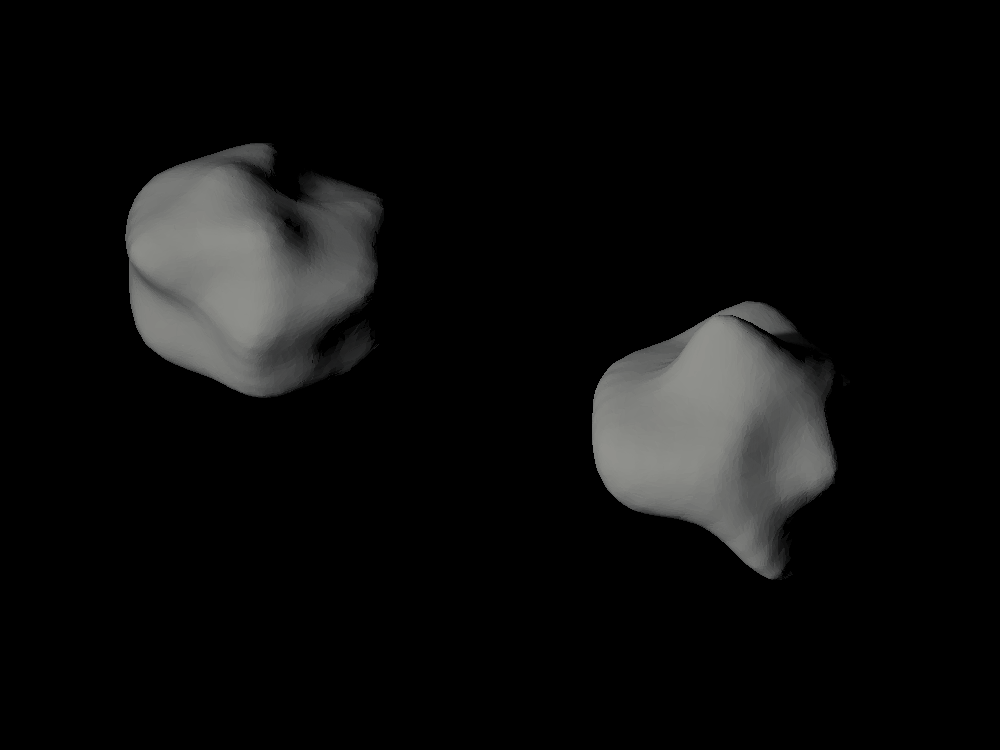
90 Antiope approximate shape scaled one in two million
prusaprinters
<p>Originally published here: <a href="https://www.thingiverse.com/thing:3742683">90 Antiope approximate shape scaled one in two million by tato_713 - Thingiverse</a></p><p>This model was made using the data from Bartczak (2014), I just resize, soften and simplified the models using Windows 3D Builder to share the same scale as other objects.</p><p>The file's names explained:<i>name_1_x_10_y.stl</i> is 1 : x* 10y. So _1_6_10_7 is 1:600000000 or one in 60 million. </p><h4>90 Antiope</h4><p>Antiope is the best example of a double asteroid, because it is composed of two bodies of nearly the same size, orbiting each other. There isn't a official definition of a binary object, so Antiope is the name of the bigger body; while the other is just its satellite. The distance between their centers of mass is 170 km, nearly two times their diameters, which means that the minimum distance between them is equal to one diameter. The most similar to a binary object in the Kuiper Belt is the Sila-Nunam system, with the two component of 250 km; the most similar to a double dwarf planet is <a href="https://www.prusaprinters.org/prints/57250-pluto-and-charon-with-known-topography-scaled-one-">Pluto and Charon</a> system, with the diameter of Charon a half of that of Pluto; and the most similar to a double planet in the Solar System is the <a href="https://www.prusaprinters.org/prints/57301-earth-with-exaggerated-topography-scaled-one-in-si">Earth</a> and <a href="https://www.prusaprinters.org/prints/57268-luna-with-exaggerated-topography-scaled-one-in-twe">Moon</a> system, being the Moon's diameter 27% of that of the Earth.</p><ul><li><strong>Type:</strong> Asteroid. Themis family </li><li><strong>Orbit:</strong> Sun. Main Asteroid Belt. </li><li><strong>Orbital period:</strong> 5.6 yr. </li><li><strong>Composition:</strong> Carbonaceous, rubble pile. C type asteroid </li><li><strong>Density:</strong> 1.25 g/cm3. <strong>*Dimensions:</strong> 93.0 km × 87.0 km × 83.6 km. </li><li><strong>Model scale:</strong> 1:1x106 (9cm) 1:2x106 (5cm)</li></ul><h4>S/2000 (90) 1</h4><p>This component is 2.5% less massive than its companion. It has a noticeably big crater.</p><ul><li><strong>Type:</strong> Binary. </li><li><strong>Orbit:</strong> Antiope. </li><li><strong>Orbital period:</strong> 16 h 30 min 18 s. </li><li><strong>Composition:</strong> Carbonaceous, rubble pile. C type asteroid </li><li><strong>Density:</strong> 1.25 g/cm3. </li><li><strong>Dimensions:</strong> 89.4 km × 82.8 km × 79.6 km. </li><li><strong>Model scale:</strong> 1:1x106 (9cm) 1:2x106 (5cm)</li></ul><h4>References</h4><p>"A new non-convex model of the binary asteroid 90 Antiope obtained with the SAGE modelling technique" MNRAS 443, 1802-1809. Bartczak. 2014. </p><h3>Other astronomical objects</h3><p><a href="https://www.prusaprinters.org/social/120859-tato_713/collections/49826">Inner Solar System</a></p><p><a href="https://www.prusaprinters.org/social/120859-tato_713/collections/49832">Artificial</a></p><p><a href="https://www.prusaprinters.org/social/120859-tato_713/collections/49820">Near Earth Asteroids</a></p><p><a href="https://www.prusaprinters.org/social/120859-tato_713/collections/49291">Main Belt Asteroids</a></p><p><a href="https://www.prusaprinters.org/social/120859-tato_713/collections/49829">Jovian System</a></p><p><a href="https://www.prusaprinters.org/social/120859-tato_713/collections/49828">Saturn System</a></p><p><a href="https://www.prusaprinters.org/social/120859-tato_713/collections/49830">Uranian System</a></p><p><a href="https://www.prusaprinters.org/social/120859-tato_713/collections/49345">Neptunian System</a></p><p><a href="https://www.prusaprinters.org/social/120859-tato_713/collections/49827">Centaurs</a></p><p><a href="https://www.prusaprinters.org/social/120859-tato_713/collections/49833">Comets</a></p><p><a href="https://www.prusaprinters.org/social/120859-tato_713/collections/49341">Trans Neptunian Objects</a></p><p><a href="https://www.prusaprinters.org/social/120859-tato_713/collections/49824">Extrasolar Objects</a></p><p><a href="https://www.prusaprinters.org/social/120859-tato_713/collections/49837">Sky Maps</a></p><p><a href="https://www.prusaprinters.org/social/120859-tato_713/collections/49831">Ancient</a></p><p><a href="https://www.prusaprinters.org/social/120859-tato_713/collections/49822">Speculative</a></p><p><a href="https://www.prusaprinters.org/social/120859-tato_713/collections/49821">Science Fiction</a></p>
With this file you will be able to print 90 Antiope approximate shape scaled one in two million with your 3D printer. Click on the button and save the file on your computer to work, edit or customize your design. You can also find more 3D designs for printers on 90 Antiope approximate shape scaled one in two million.
